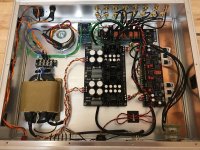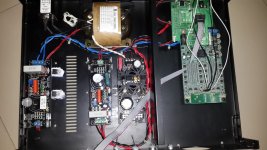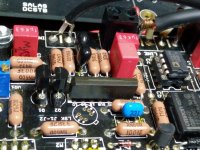Ok fine, based on the VA + the required voltage they test the current. Let me mail them and see.
They most likely already know what current each of their VA size models does at 36V CT i.e. 18+18. Because its one of the standard secondary voltages in the industry.
@Salas,
I haven't got any reply from Shilchar but my usual local supplier (EMD company) came back with the quotation for 2 quantities RCORE of the following ratings:
0-230v Primary
0-18v @ 500mA
0-18v @ 500mA
The price looks reasonable and I know their quality is good as I am using their RCOREs for BiBs for my DAC and BA3 preamps and many other. One question is that I may eventually go with dual mono BiB PSU boards but currently have one set of +/-IRF boards so using the above rated transformer which comes to only 1A per transformer. But as per your earlier recommendation to use atleast 1.75A if single transformer may not be sufficient till I get another set of BiB's?
Edit: Should I just make each secondary to 1A so that one RCORE comes to 2A ratings but using dual mono setup might be too high current?
I haven't got any reply from Shilchar but my usual local supplier (EMD company) came back with the quotation for 2 quantities RCORE of the following ratings:
0-230v Primary
0-18v @ 500mA
0-18v @ 500mA
The price looks reasonable and I know their quality is good as I am using their RCOREs for BiBs for my DAC and BA3 preamps and many other. One question is that I may eventually go with dual mono BiB PSU boards but currently have one set of +/-IRF boards so using the above rated transformer which comes to only 1A per transformer. But as per your earlier recommendation to use atleast 1.75A if single transformer may not be sufficient till I get another set of BiB's?
Edit: Should I just make each secondary to 1A so that one RCORE comes to 2A ratings but using dual mono setup might be too high current?
Last edited:
Hi manniraj, I use Shilchar made R-Core on one of my DCG-3 units and have no regrets. I’m also the lucky one since I got 4 of these tranys from French Selectornic right prior they got out of business. I advice to call them directly. I did, since my tranys arrived without any diagram or data sheet. They have free (at least from US) number to call for customer support. I have 120VA single one (60VA for channel) and I did afraid about little overkill with unnecessary flux, but was not the case and have no any issue. They are (like Salas mentioned) very high quality transformers.


@manniraj
BiB is constant current sourced and it uses spare current to keep its shunt power element well biased too. Full bridge rectification drops any transformer's current delivery spec by 40%. Those things together call for a large enough transformer not to get hot. R-Core has the advantage of running 30% cooler than an EI.
Read post #79 about DCG3's power needs for easy or hard output load and the minimum BiB CCS settings. Add 50mA more per rail if going with the high bias 7.5 Ohm R10 resistors. All of the above lead us again to about 1A for double mono and about 2A shared R-Core minimums for not much hot operation.
Also when using a BiB configure it in two wire classic output mode for the DCG3 because I have seen oscillation tendencies in a friend's matrix board early beta test build that was using a common BiB in Kelvin mode between channels. Two wire mode with thick enough cables fixed that issue.
BiB is constant current sourced and it uses spare current to keep its shunt power element well biased too. Full bridge rectification drops any transformer's current delivery spec by 40%. Those things together call for a large enough transformer not to get hot. R-Core has the advantage of running 30% cooler than an EI.
Read post #79 about DCG3's power needs for easy or hard output load and the minimum BiB CCS settings. Add 50mA more per rail if going with the high bias 7.5 Ohm R10 resistors. All of the above lead us again to about 1A for double mono and about 2A shared R-Core minimums for not much hot operation.
Also when using a BiB configure it in two wire classic output mode for the DCG3 because I have seen oscillation tendencies in a friend's matrix board early beta test build that was using a common BiB in Kelvin mode between channels. Two wire mode with thick enough cables fixed that issue.
What I understand when you say 2-way classic output wiring for the BiB for the DCG3 is that I need to use dual wires on the DC output for each + and 0 of the +/-IRF boards. If you look at the below pic from my Soekris DAC build where I am using the BiB + Ref-D boards I think I have used the same logic of taking out the wires. Is this what refers to the classic 2-way?
Attachments
Thanks Salas, looking at the pic I just need to jumper the +F,+S and F0,S0. After this just use single wires on either +F/+S which becomes the positive wire and another single wire on either F0/S0 which becomes the ground and connect to a multi-wire adapter so that I can run multiple output wires to power the 2 channels on the DCG3's DC inputs. This is the classic 2-way wiring when compared to my above pic which is the Kelvin mode.
I followed Salas guide re the two wire connection of the SSLV regs to the DCG3 and must say that I am very pleased with the results; although I actually went dual mono. The sound is extremely detailed and dynamic without being tiring to listen to over several hours.
@ manniraj
Yes that's the procedure but don't forget to do the negative side also. -F/-S F0/S0.
Yes that's the procedure but don't forget to do the negative side also. -F/-S F0/S0.
Thanks Salas, yes of course as you said it also applies to the -IRF board as well. I have placed the order for the new RCORE from my local vendor for 0-18V @1A *2 + 0-12V@1A (this planning to use for other internal usage like a tube buffer etc.,). Should get it by next week, so in the meantime planning to solder the DCG3 and wait for the RCORE and test it out and pair it with my Sony VFET2 amp.
My take on Q1,Q2 BC327-40
So I picked and matched two pairs of 500+ Hfe BC327-40 BJTs and also checked for their curves align on the tracer within each pair. I used Atlas DCA75 to both identify Hfe and trace. Then I disassembled my preamp and put a row of three 0.1 inch (2.5mm) pitch female header pins for each transistor position that I cut out from a bar of 40. The BJTs legs fit snugly in those gold plated headers that are exactly what the usual DIP-8 good quality opamp sockets have organized in a frame.
First I checked with the gen and the scope that nothing went wrong or no alarming spec change was imposed by these smaller current gain bandwidth product (Ft) but also lower noise BJTs. The preamp achieves 2.7MHZ -3dB HF extension when with the pot wide open (no pot's impedance added to the 50Ω generator) and the rise times on various kHz and attenuation level square waves are still roughly as before.
On same day I listened with the Sennheiser HD 600. The next day I listened to the same music on my DIY tower speakers which have Tangband doubled up oval woofers, a PHL 6.5 inch midrange and a Celestion 1 inch exit compression driver on a FaitalPRO aluminum tactrix horn. Power amp was Mirand Audio TSSA V1.7 modules fed from a CM Darlington BJT supply of my own. Player was Foobar on Wasapi event mode XMOS driver and DAC was the Aune S16. I went through various genres of music tracks with up to 352800 Hz sampling rate.
To cut it short I am with Alex on this. Brings more meaningful character to the preamp's musical rendition. Deeper digging into detail and better focused in a smoothly cleaner kind of way. Not shouting "upgrade!" but bringing it out in a calm but surefooted manner. I did not hear any kind of rounder or ripe tonal tendency though. Maybe its a matter of particular sound systems and building parts synergy or simply down to the rigorous matching and high Hfe that I kept about to what Hfe my BC560s were. Those original ones brought the musical picture out bit more enthusiastically maybe but the alternative ones are helping even closer to natural in my humble opinion. I can listen at one click louder before its too loud. Talking about small things that are arguably prone to be swamped or shine between different audio systems but on the other hand in this kind of performance level they are also worth mentioning and exploring. For the enthusiasts every clue is useful nonetheless.
All in all I recommend you guys try for yourself and decide which rendition you prefer better or which one simply matches your build and the rest of your system better. As for me I am keeping those 327s as installed in the picture.
So I picked and matched two pairs of 500+ Hfe BC327-40 BJTs and also checked for their curves align on the tracer within each pair. I used Atlas DCA75 to both identify Hfe and trace. Then I disassembled my preamp and put a row of three 0.1 inch (2.5mm) pitch female header pins for each transistor position that I cut out from a bar of 40. The BJTs legs fit snugly in those gold plated headers that are exactly what the usual DIP-8 good quality opamp sockets have organized in a frame.
First I checked with the gen and the scope that nothing went wrong or no alarming spec change was imposed by these smaller current gain bandwidth product (Ft) but also lower noise BJTs. The preamp achieves 2.7MHZ -3dB HF extension when with the pot wide open (no pot's impedance added to the 50Ω generator) and the rise times on various kHz and attenuation level square waves are still roughly as before.
On same day I listened with the Sennheiser HD 600. The next day I listened to the same music on my DIY tower speakers which have Tangband doubled up oval woofers, a PHL 6.5 inch midrange and a Celestion 1 inch exit compression driver on a FaitalPRO aluminum tactrix horn. Power amp was Mirand Audio TSSA V1.7 modules fed from a CM Darlington BJT supply of my own. Player was Foobar on Wasapi event mode XMOS driver and DAC was the Aune S16. I went through various genres of music tracks with up to 352800 Hz sampling rate.
To cut it short I am with Alex on this. Brings more meaningful character to the preamp's musical rendition. Deeper digging into detail and better focused in a smoothly cleaner kind of way. Not shouting "upgrade!" but bringing it out in a calm but surefooted manner. I did not hear any kind of rounder or ripe tonal tendency though. Maybe its a matter of particular sound systems and building parts synergy or simply down to the rigorous matching and high Hfe that I kept about to what Hfe my BC560s were. Those original ones brought the musical picture out bit more enthusiastically maybe but the alternative ones are helping even closer to natural in my humble opinion. I can listen at one click louder before its too loud. Talking about small things that are arguably prone to be swamped or shine between different audio systems but on the other hand in this kind of performance level they are also worth mentioning and exploring. For the enthusiasts every clue is useful nonetheless.
All in all I recommend you guys try for yourself and decide which rendition you prefer better or which one simply matches your build and the rest of your system better. As for me I am keeping those 327s as installed in the picture.
Attachments
Hi Salas, where have you purchased your BC327? Unfortunately, none of mine got to that high Hfe. I used 375 and 346 pairs. The highest I got were in 400 range, but I could not get them to match. Is it from Mouser? On-Semi? Nice idea about headers. I regret that I did not do it in that way.
Last edited:
Those I have are leftovers from some years ago. They should be Diotec brand purchased in Europe. They are in ammo pack (cowboy legs row on a tape). Not very consistent but they score many hits well over 400 Hfe with few extra strong ones hitting over 500.
BTW what you use to measure Hfe? Because testers differ in the currents they use. So they can be OK to match Hfe but its absolute number won't follow other people's measurements when using another tester.
I use Atlas DCA75, same as yours I guess. Not sure about its accuracy (I do not have any standard-reference), but precision is very tight. I’ll try to get 20 more from Mouser and see if that batch has higher Hfe.
See to sample different brands. Also the room temperature should be the same when comparing noted down results from different sessions. And don't grab them with fingers but use a tool. Fingers transferred heat is enough to unsettle them for a while. Something helpful is we run them only at around 2mA-2.5mA Ic in the DCG3 circuit, so if your high Hfe hitting ones are matching their Ib labeled curves well at the Ic/Vce test chart's bottom half but differ in its upper half, its preferable to use those than well lower Hfe ones that match all over the different Ib curves. Always check that the tester's parameters are still the same when tracing close enough Hfe samples. Strong Hfe 327s will keep the OLG of the preamp near to what it is with the BC560s for a fairer subjective comparison.
I remeasured all with that precaution way and got bit higher values in steady room temperature. What % of matching is considered to be sufficient? I have high Hfe once with values equal to 425/420/418/407. All the rest is in the range of 340-360. I’m looking for the set to upgrade my second unit with LDR volume control.
- Home
- Source & Line
- Analog Line Level
- Salas DCG3 preamp (line & headphone)


